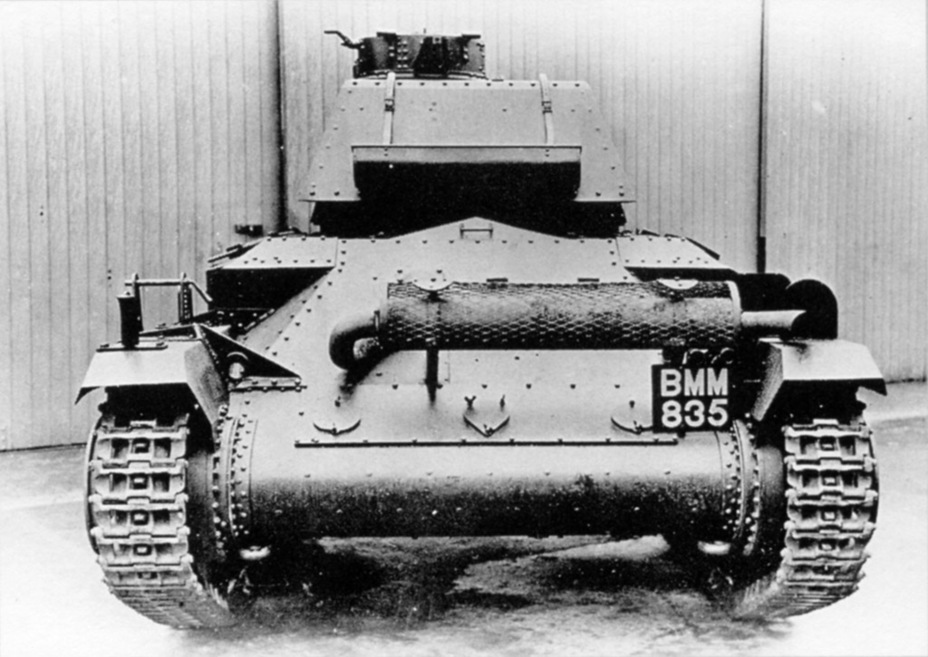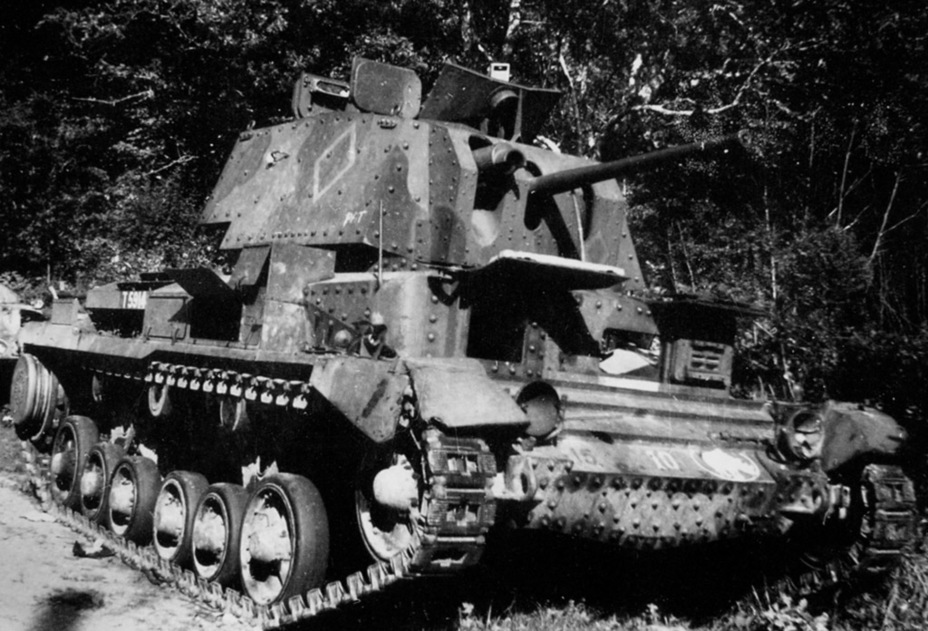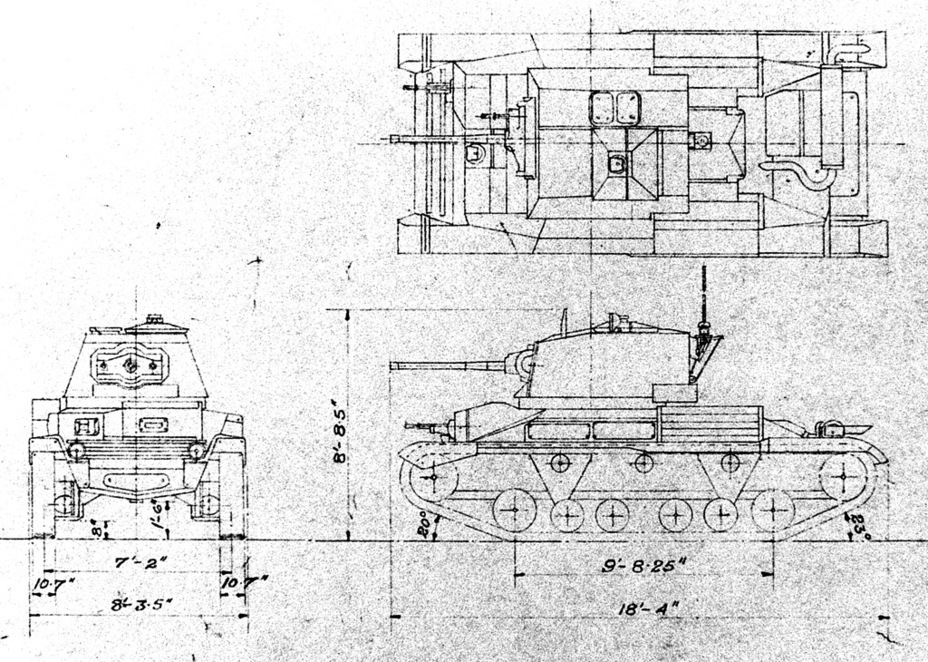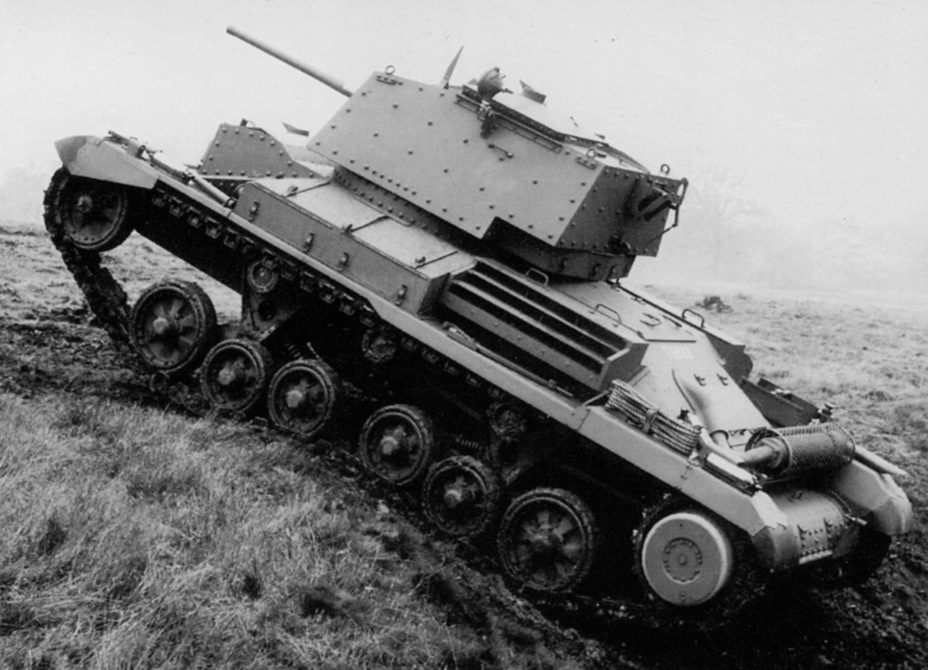The British army met the start of WWII in a difficult position. The policy of appeasement allowed it to win a year to set up tank production, but it was hard to call the British army prepared for war. This can be seen in the result of the fighting in May of 1940 in France. The British Expeditionary Force used four different types of Cruiser tanks at the same time. Among them was the Cruiser Tank Mk.II, perhaps the most controversial of the quartet.
Half-infantry tank
The story of the Cruiser Tank Mk.II begins in the spring of 1936. The Tank, Experimental, Medium, A9E1, developed as a part of the medium tank program, entered trials in April. The medium tank program was also in trouble: work on finding a successor for the Medium Tank Mk.II was going on for nearly a decade. A new tank, designed under the direction of Leslie Little, showed itself more reliable than its unlucky predecessors. This was primarily due to the suspension, which the British had bad luck with. In addition, the tank turned out to be smaller and lighter, but with the same armour thickness and comparable firepower. The A9E1 also had acceptable mobility. Finally, a replacement for the Medium Tank Mk.I and Medium Tank Mk.II was found.

The A9E1 was seen as a prospective platform for another type of vehicle. Back in 1934, requirements for two types of infantry tanks were developed in Great Britain: medium and light. The light tank received the index A11, and after a number of metamorphoses it was accepted into service as the Infantry Tank Mk.I. Requirements for the second tank described a vehicle with a 2-pounder cannon and a machinegun with 25 mm thick armour. Vickers-Armstrongs had the idea to build this tank on the A9 platform, especially since increasing the armour to 25 mm would still let the tank reach the required speed of 16 kph. The tank also already had a three-man turret, which was one of the requirements for the medium infantry tank.

The first issues cropped up during the development of the vehicle, indexed A10. The British military changed the requirements for protection. Now they wanted 60 mm of armour. The A9 chassis was not prepared for such a leap in mass. A compromise was reached with 30 mm of armour. This armour couldn't protect from an anti-tank gun, but it could hold out against 20 mm autocannon fire.
The British military was hardly thrilled, but nevertheless Vickers-Armstrongs received permission for construction of the Experimental Tank A10E1. This vehicle received the WD number T.1479 and registration number BMM835. It entered trials in July of 1937.

The tank was almost identical to its predecessor from the technical point of view. It even retained the 120 hp Rolls Royce Phantom II engine, which showed itself poorly during A9 trials. The biggest difference was a new front hull. Since the infantry variant didn't need machinegun turrets, they were removed. The tank received a sloped upper front plate. The driver's cabin was altered. Special strips were added to the upper front plate to deflect bullets and shell fragments. The rear part of the hull around the engine compartment also changed. The thicker armour was one of the more subtle changes, being only noticeable around plate joints. Reinforcement of the drive sprocket armour was also visible.

The removal of machinegun turrets reduced the mass a little, but the A10E1 was still more than a ton heavier than its predecessor. This was the cost of thicker armour. Issues with the engine were even more pronounced on this tank than on its predecessor. Meanwhile, the A10E1 ceased to be seen as an infantry tank, as work on the A12, better known as the Matilda, began. This tank had 75 mm of armour, which surpassed any protection requirements.
Nevertheless, the A10 was in no danger of being stuck as a prototype. The British army dispensed with the medium tank class. Instead, they now had cruiser tanks, which had high mobility with thin armour. However, at the time there was no cruiser tanks in existence, so the A9 was classified as a cruiser. As for the A10, it was referred to as a Heavy Cruiser Tank. As with the A9, this seemed a measure of desperation. The A10 could not boast its mobility. Of course, the top speed of 25.6 kph was more impressive than the 16 kph required of an infantry tank, but even compared to the A9's 40 kph this seemed very humble.

The reclassification into a «heavy cruiser» reflected on the A10E1's exterior. The tank was altered, which changed it visually. The 150 hp AEC A179 replaced the Rolls Royce Phantom II, which changed the engine deck. The cruiser tank required a bow machinegun. The tank's designers refused to add a machinegun turret, so the tank received a wider driver's compartment. The driver was pushed to the left, and space freed up to the right for the gunner. The intention was to use the BESA machinegun (licensed clone of the Czechoslovakian ZB.53 machinegun), but it was not yet finished, so a dummy was used in its place.
Trials showed that the tank has satisfactory characteristics. A second prototype called A10E2 was built. The goal with this tank was to test the suspension for the infantry tank codenamed Valentine. The tank was loaded to the mass of this future infantry tank.
Between the Cruiser Tank Mk.I and the Valentine
The results of the trials triggered another wave of changes for the A10E1. The turret lost its commander's cupola. Changes were identical to those made to the A9 Mk.I turret, with the main difference being the thicker armour. The front of the hull and its internal equipment also changed. In the final version, an additional 143 L fuel tank was installed to the right of the driver. This noticeably increased the tank's range, but it's unlikely that the driver was happy to have such a neighbour. It had to have been unsettling to hug 143 L of fuel splashing around in the most vulnerable part of the tank. The final version of the A10 Mk.I weighed 14 tons, nearly 1.5 tons more than the A9 Mk.I. Of course, this excess weight came at a price.

Unlike the A9 Mk.I, Vickers-Armstrongs distanced itself from A10 production. The company already had a contract for the A9 Mk.I, and work on the Infantry Tank Mk.III was underway. The A10 was the odd man out. Elswick Works produced only 10 A10 Mk.I with WD numbers T.8091-T.8100 and registration numbers PMX448-PMX457. A much larger contract was given to the Birmingham Railway Carriage and Wagon Company (BRC&W). 75 tanks with WD numbers T.5909-T.5983 and registration numbers RMV264-RMV338 were produced there. 75 more tanks were built by Metropolitan Cammell Carriage and Wagon Company (MCCW), one of the subsidiaries of Vickers-Armstrongs. The tanks built here had WD numbers T.9191-T.9265, and did not receive registration numbers. Finally, the largest contract for 100 A10s was to be made with the R. W. Crabtree and Sons company, but in reality it was reduced to 10 tanks with WD numbers T.15115-15124.

The first tanks began leaving the factories in late 1939. At this time, British tanks were transitioning from Vickers to BESA machineguns, which reflected on the heavy cruisers. The bow gun was a BESA, but the turret housed a coaxial Vickers gun. These machineguns used a different caliber, and the British could scarcely afford such luxury. As a result, production A10 Mk.Is drove around without bow guns or bow gunners.

Not surprisingly, the A10 Mk.I did not last in production for long. Only 45 were built, 12 at MCCW and 13 at BRC&W. In addition to coaxial Vickers guns, these tanks had additional armour on the front of the turret. The Cruiser Tank Mk.IV received similar armour. These tanks did not spend much time in service and disappear almost completely from photographs after the defeat of the British Expeditionary Force.

A new variant of the tank went into production in the spring of 1940. This tank was indexed A10 Mk.IIA. Its biggest difference was the addition of the No.3 gun mount, which was also used on a number of Cruiser Tanks Mk.IVA. It combined a 2-pounder gun and a coaxial BESA machinegun. The bow gun and bow gunner returned. This version of the tank was the most common. Another variant of the tank appeared around this time, the A10 Mk.IA CS, armed with a 94 mm howitzer. 30 of these support tanks were built at MCCW.

The peak of A10 production was hit in the spring-summer of 1940. In June 1940 the tanks changed their name: the A10 Mk.I became the Cruiser Tank Mk.II, and later versions were called Cruiser Tank Mk.IIA and Cruiser Tank Mk.IIA CS. The results of fighting in France showed that this tank has no future. In the fall of 1940 production began to wane in favour of the Infantry Tank Mk.III. R.W. Crabtree and Sons was the last company to produce this tank. Constant delays resulted in the last tanks only being delivered in July of 1941. By this time, their army career was at an end.
Slow and unsteady
Many publications dedicated to British tanks pick the Covenanter as their whipping boy. A number of mistakes made in the design meant that the tank never saw combat. There was also a tank that saw battle, but its level of reliability rivalled the Covenanter's. This was the Cruiser Tank Mk.II.

The first Cruiser Tanks Mk.II entered service in early 1940. These were the initial type, with coaxial Vickers machineguns and without bow guns. The Royal Tank Corps received 42 Cruiser Tanks Mk.II before the end of June of 1940, including the first Cruiser Tanks Mk.IIA. The tanks were first sent to fill up the 1st Armoured Division. Since production was just starting, the saturation progressed slowly. 11 tanks were listed in the 1st Armoured Division by April of 1940, 19 by May, and 31 tanks by the start of the fighting. The tankers did not have time to master their vehicles, which, combined with the expected issues of initial production tanks, coloured the A10's debut.

The German offensive on May 10th, 1940, caught the British by surprise. At this point the 1st Armoured Division was still being outfitted in England. Elements of the division began landing in Calais and Cherbourg starting on May 20th. The 3rd Royal Tank Regiment was the first to see combat. The result of the fighting was sad: as of May 25th, only 3 out of 30 cruiser tanks remained. The total losses of the division by the end of May were 89 cruiser tanks, including 17 Cruiser Tanks Mk.II.
The main cause of losses was not enemy fire. German front line photo albums are full of Cruiser Tanks Mk.II pictured abandoned in ditches and on road shoulders. The cause of this was the series of technical issues that plagued the tank. There is nothing surprising about this. With the same technical «guts» as the Cruiser Tank Mk.I, the Cruiser Tank Mk.II was 1.5 tons heavier. Considering that the tank's predecessor was not a star of reliability to begin with, the result was predictable. Only 2 Cruiser Tanks Mk.II were lost to enemy fire, the remaining 12 tanks were victims of breakdowns.

Operation Dynamo, the evacuation of the British Expeditionary Force, began on May 26th. French units evacuated as well. Elements of the 1st Armoured Division fought to protect the evacuation sites at Dunkirk and Calais. A portion of personnel were successfully evacuated, but the majority of the tanks, including cruisers, were abandoned.
The tanks were briefly used by the French army during the evacuation. After the evacuation of 5 RTR crews, a number of tanks remained in the possession of the French 342nd Independent Tank Regiment, which returned from Norway, having lost their Hotchkiss H 39 tanks. They took over 10 British tanks, including several Cruiser Tanks Mk.II. Alas, there is no detailed information about the use of the tanks in the 342nd CACC. The only thing that can be said for certain was that they took part in the defense of Calais, where French and British forces were evacuated from.

All British Cruiser Tanks Mk.II became German trophies as a result of the May-June 1940 campaign. The Germans were not in a hurry to use these tanks. The scattered hulks gave a lot of food for thought. The Cruiser Tank Mk.II seemed questionable even as a training tank.

The Germans called the tank Panzerkampfwagen Mk II 742(e). The fate of most of them was the same as of the Cruiser Tank Mk.I: exhibitions, then junkyards. A number of tanks ended up in training units, and one ended up in Kummersdorf. In April of 1945 it was sent into battle against the Red Army alongside a number of other trophies. The result was predictable: the tank broke down and it was shoved into a ditch.

The high breakdown rate of the Cruiser Tank Mk.II did not end its combat career. There was a plan to send these tanks to North Africa in June of 1940, but in practice the tanks were not sent until the fall of 1940, and even then in small amounts. These were Cruiser Tanks Mk.IIA with BESA machineguns. Like the Cruiser Tank Mk.I, these tanks received a sand shield from the left side, which reduced the amount of dust that was kicked up during driving. A number of tanks also received additional fuel tanks. Of course, these increased the cruising range, but the question of why put 135 L of fuel on top of the left fender right in the front is a tough one to answer. It was hard not to hit it, and not hard to imagine the consequences of such a hit.

Large scale shipments of the Cruiser Tank Mk.II to Africa began in early 1941. 101 tanks arrived by April 1st, including 12 Cruiser Tank Mk.IIA CS. At the time, this was the most numerous cruiser tank in the region.
Technical issues continued to plague the Cruiser Tank Mk.II. Dust and heat were additional stressors. Mass issues with the clutch cropped up. The suspension, road wheel rims, and track links suffered in the African climate. The British were fighting not only the enemy, but their own tanks.

The use of these tanks in Greece was the peak of technical problems. The British sent the 3rd RTR in anticipation of a German invasion, which was filled with Cruiser Tanks Mk.IIA and Cruiser Tanks Mk.IVA. The 3rd RTR had nearly no losses from enemy fire during the fighting in Greece. The unreliable tanks defeated themselves. A critical lack of spare parts made the situation worse. Cruiser Tanks Mk.IIA abandoned on the roadside became a symbol of British participation in the Greek campaign in the spring of 1941. On April 27th, the personnel of the 3rd RTR boarded transports for Crete, having made nearly no impact on the fighting in Greece.

North Africa was the only theatre where the Cruiser Tank Mk.II showed itself in some form of positive light. The thick armour helped, although not always. These tanks played an important role in the fighting of spring-summer 1941. Measures to keep the tanks in working order paid off, and by September 1941 the breakdown rate was reduced. Out of 42 tanks, 31 were functional and ready for battle. By early November, the number of working tanks increased to 52.
Nevertheless, the fate of the tanks was sealed. Operation Crusader was the last that saw early Cruisers (Mk.I though Mk.IV) fight as first line tanks. The appearance of more modern British and American vehicles allowed them to retire. The Cruiser Tank Mk.IIA was used on Cyprus until early 1943. There was also an attempt to use the Cruiser Tank Mk.II as a bridgelayer, but it turned out that even the Covenanter was better suited for this role.

Surviving Cruiser Tanks Mk.II were used as training tanks. They were freed from this duty in 1943 as hopelessly obsolete. One of these tanks, a Cruiser Tank Mk.IIA CS got lucky, and can now be seen at the Bovington tank museum. Remains of another tank were recently discovered, and a group of enthusiasts is trying to restore this vehicle.
The fate of the Cruiser Tank Mk.II shows how poor the situation with tank building was in Britain at the start of WWII. After that, it's hard to be surprised at the enthusiasm that British tankers showed at the Light Tank M3 that entered service in August of 1941. One can say without a shadow of a doubt that the British army was saved by Lend Lease.
Translated by Peter Samsonov. Read more interesting tank articles on his blog Tank Archives.
Sources:
- http://tankdevelopment.blogspot.ru
- British Cruiser Tanks A9 & A10, Peter Brown, Model Centrum Progres, 2017, ISBN 978-83-60672-28-0;
- National Archives and Records Administration;
- Author's photo archive.






